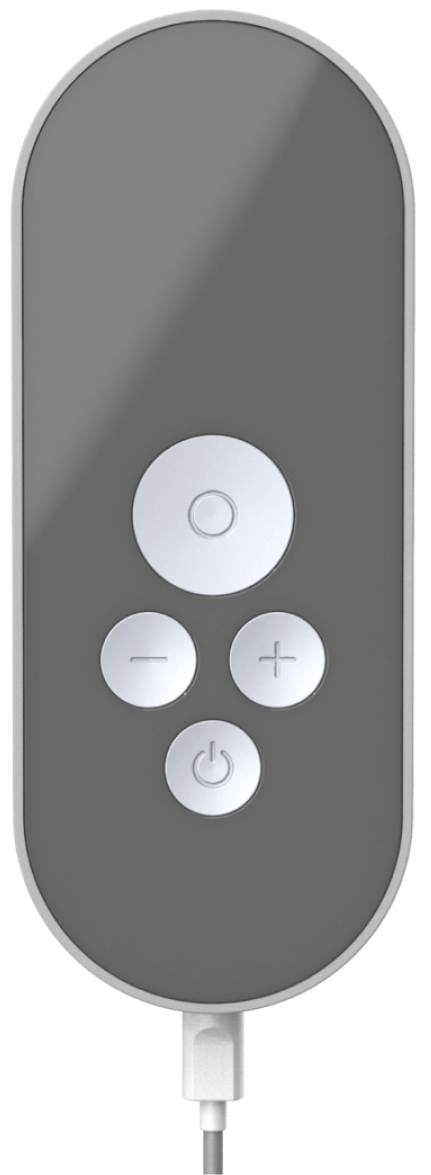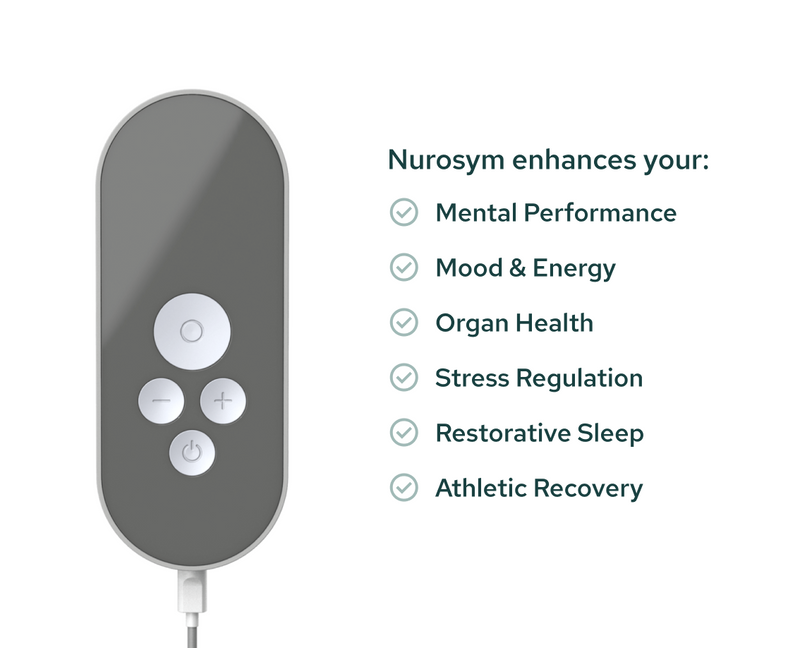Guarding Against Dementia: The Vagus Nerve
The vagus nerve, a key component of the parasympathetic nervous system, not only regulates autonomic bodily functions but also plays a crucial role in modulating communication between the brain and the rest of the body. Given its integral role in numerous physiological processes, there is a compelling suggestion that impairment of the vagus nerve may contribute to the development and progression of dementia, caused by:
Microbiome-Brain Axis Disruption
The vagus nerve plays a role in the bidirectional communication between the gut and the brain, known as the gut-brain axis. Disruption of this axis due to vagus nerve impairment may lead to alterations in the gut microbiome, with potential consequences for brain health. Emerging research indicates a potential link between the composition of the gut microbiome and the risk of developing dementia, possibly through inflammatory effects¹.
Blood-Brain Barrier Dysfunction & Neuroinflammation
The vagus nerve is involved in the regulation of the blood-brain barrier (BBB), the integrity of which protects the brain against harmful substances. Vagal dysfunction through inflammatory pathways and hormonal signalling can alter the dynamics of brain communication, allowing potentially damaging molecules to enter the brain. This disruption may contribute to neuroinflammation and neuronal damage associated with the progression of dementia².
Neurogenesis Impairment
Impairment of the vagus nerve is linked to diminished neurogenesis, the generation of new neurons, especially in crucial areas for memory and learning like the hippocampus. This decline in neurogenesis may impede the creation of fresh memories and the capacity to acquire new information, a significant challenge in the context of dementia³'⁴.
Amyloid Beta Accumulation
Vagus nerve dysfunction may facilitate the accumulation of beta-amyloid plaques in the brain and disrupt the process of clearing them. These plaques, along with tau proteins, contribute to pathological changes and increased inflammation of the nervous system. Their accumulation promotes and contributes to the development of dementia⁵.
- Chandra S., Sisodia S.S. & Vassar R.J. (2023). The gut microbiome in Alzheimer’s disease: what we know and what remains to be explored. Mol Neurodegeneration 18, 9.
- Knox E.G., Aburto M.R., et al. (2022) The blood-brain barrier in aging and neurodegeneration. Mol Psychiatry 27, 2659–2673.
- O’Leary O.F., Ogbonnaya E.S., et al. (2018). The vagus nerve modulates BDNF expression and neurogenesis in the hippocampus. European Neuropsychopharmacology, 28, 2, 307-316.
- Suarez A.N., Hsu T.M., et al. (2018) Gut vagal sensory signaling regulates hippocampus function through multi-order pathways. Nat Commun 9, 2181.
- Vargas-Caballero M., Warming H., et al. (2022). Vagus Nerve Stimulation as a Potential Therapy in Early Alzheimer’s Disease: A Review. Sec. Brain Imaging and Stimulation 16.
Nurosym facilitates the transmission of signals affecting memory and cognitive function from the intestines to the brain. Studies have highlighted the positive impact of Nurosym, indicating its anti-inflammatory effects that enhance nutrient absorption in the intestines through microbiota. Consequently, the reduction in inflammation can lead to improved gut-derived neurotransmitter production as a response to inflammation. Additionally, similar findings were summarised in the journal Molecular Neurodegeneration, which identified associations between the gut microbiome and the pathophysiology of Alzheimer's disease (AD).
Nurosym, renowned for its anti-inflammatory properties and its proven memory effect, is believed to offer potential benefits in addressing issues related to cerebral blood supply and blood-brain barrier dysfunction. The Nurosym’s research has shown that it can reduce inflammation in the nervous system by influencing neuropeptide Y (NPY). NPY can influence the activity of brain neurotrophic factor, which supports the differentiation of new neurons and synapses. This correlation can affect brain structure by alleviating issues like barrier breakdown, brain swelling, and nerve cell damage that are associated with neurogenic inflammation. Consequently, Nurosym has the potential in enhancing learning cognitive, and motor functions, and mitigating the progression of neuroinflammatory diseases.
The Nurosym device has exhibited improved memory functions. By lessening inflammation and oxidative stress, Nurosym can potentially contribute to neuroprotection of the brain cells. This neuroprotective effect is believed to mitigate damage to nerve cells as evidenced by inflammatory response. Moreover, the neuromodulation research offers data supporting the protection of specific brain cells in the hippocampus by increasing brain-derived neurotrophic factor (BDNF), indicating potential benefits in addressing memory and cognitive challenges in individuals with dementia.
Nurosym is hypothesised to improve fundamental communication among brain cells (synapses), enhancing cognitive abilities through the modulation of signals associated with inflammation response. Nurosym has shown positive outcomes on inflammatory markers in research studies through modulating the vagus nerve. Some studies suggest that vagus nerve, through this mechanism, may increase adaptability and reduce brain beta-amyloid and block arteries plaque accumulation, offering the possibility of slowing down and mitigating the severity of Alzheimer's disease.
Nurosym Research-Based Evidence
73% of users noted improved cognition and memory after using Nurosym, demonstrating significant enhancements in dementia symptoms and overall productivity.
In clinical trials patients within 5 days demonstrated 32% enhanced memory and 26% learning performance with Nurosym, showing significant improvements in both speed and accuracy on various cognitive tasks compared to placebo.
After 2 weeks of Nurosym neuromodulation therapy, patients experienced an average of 57% improvement in cognition related to ME/CFS as evidenced in clinical trials.
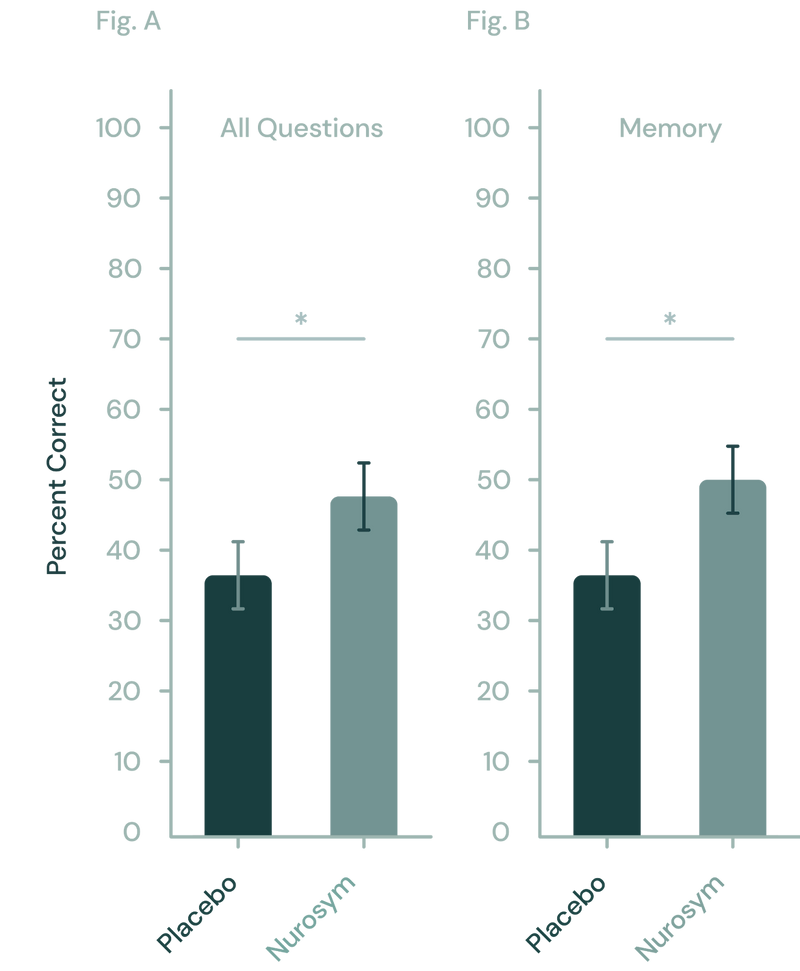
Nurosym has shown to enhance memory in learning tasks relative to a placebo. (A) Across all test questions, Nurosym's neuromodulation demonstrated a notable advantage over placebo. (B) Specifically, this improvement was largely due to the significant impact of Nurosym neuromodulation on memory-related questions (Parasym Clinical Trials, 2020)
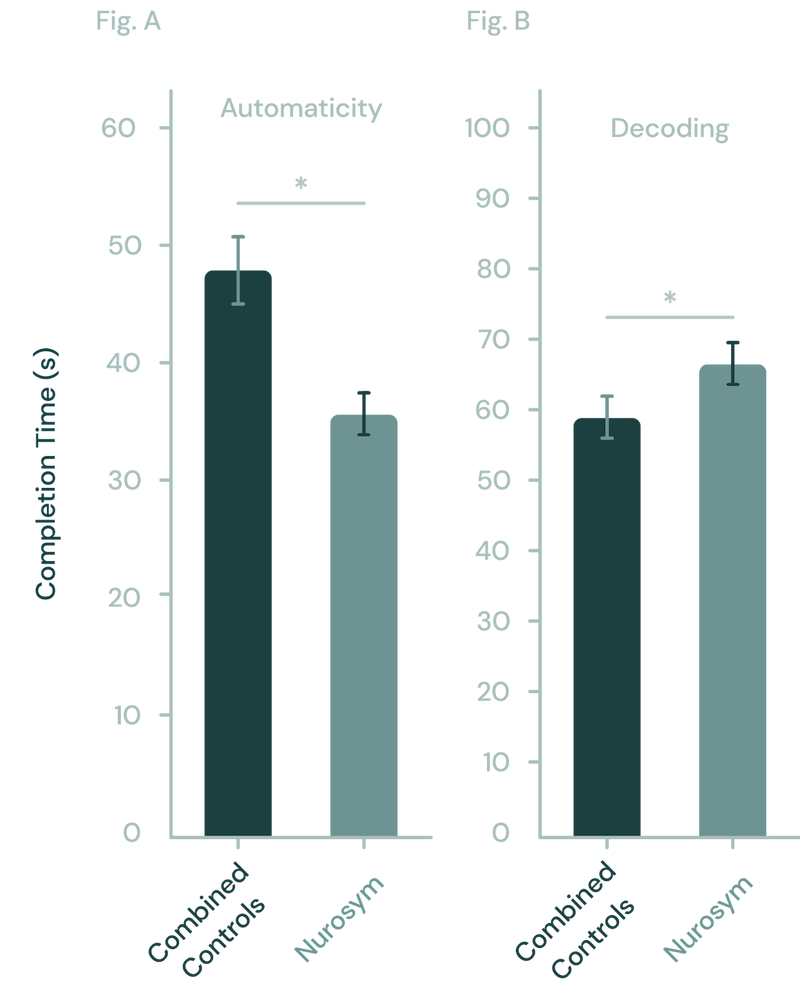
In the study, pairing Nurosym neuromodulation with training notably enhanced speed performance in the Automaticity learning task (significantly, *p<0.05), compared to placebo controls. Additionally, Nurosym neuromodulation significantly improved accuracy, as measured by the percent correct, in the Decoding learning task when compared to controls (*p < 0.05) (Parasym Clinical Trials, 2020)
In clinical trials, participants were assessed at three key time points: baseline (Day 0), post-intervention (Day 10), and at a 1-month follow-up. The intervention led to significant cognitive improvements, with performance in Flanker Inhibitory Control and Attention increasing by 11%, and overall Fluid Cognition improving by 17%.
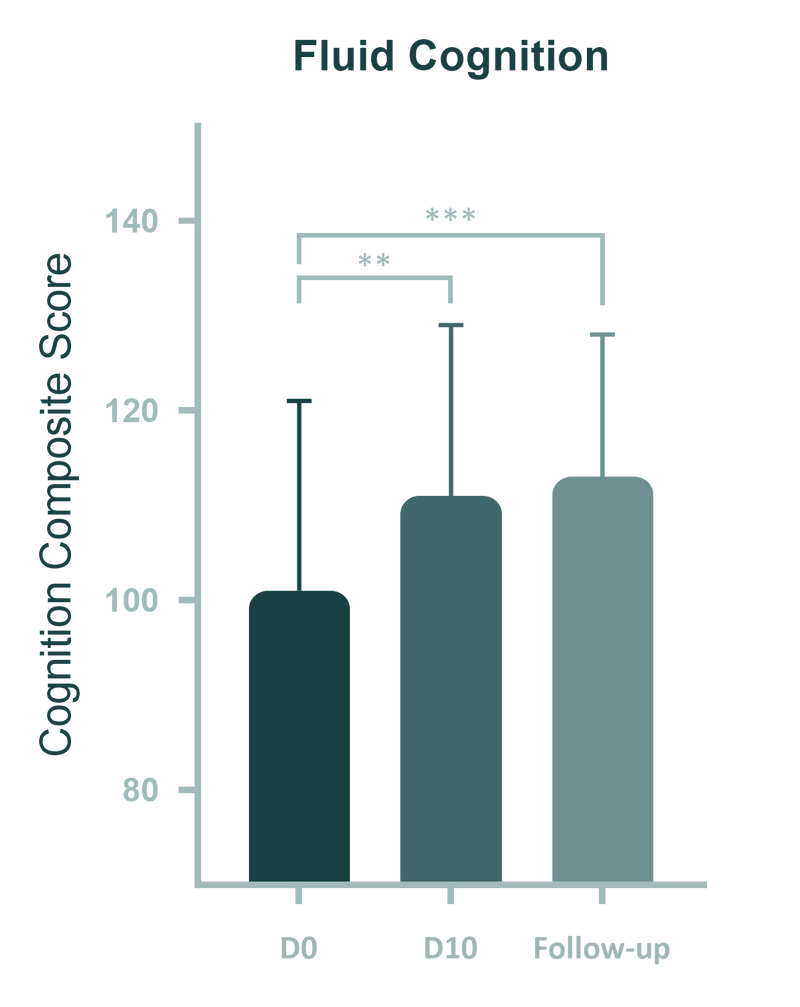
(Fig). The Fluid Cognition Score represents cognitive performance across several domains, including Pattern Comparison Processing Speed, Pattern Sequencing Memory, and List Sorting Working Memory. The study showed significant increases from baseline to post-intervention and follow-up (p < 0.01). Friedman’s test indicated a significant main effect of time (p = 0.001) across all composite cognitive scores.
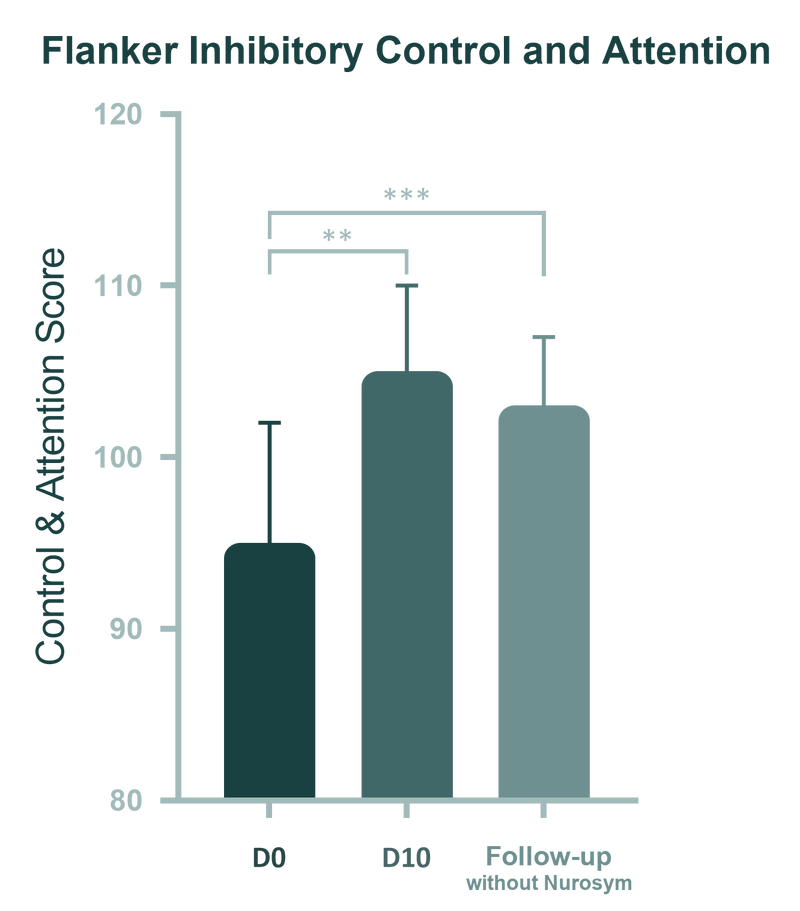
(Fig). Participants were tested at three points: baseline (Day 0), post-intervention (Day 10), and 1-month follow-up. Significant improvements were found in Flanker Inhibitory Control and Attention from baseline to post-intervention (p = 0.009) and follow-up (p < 0.001).
In clinical trials, after Nurosym neuromodulation, patients experienced a 38% decrease in neuropeptides (such as NPY) levels, indicative of diminished neurogenic inflammatory processes in the brain. This reduction is associated with a decrease in neurodegenerative processes and stress reactions.
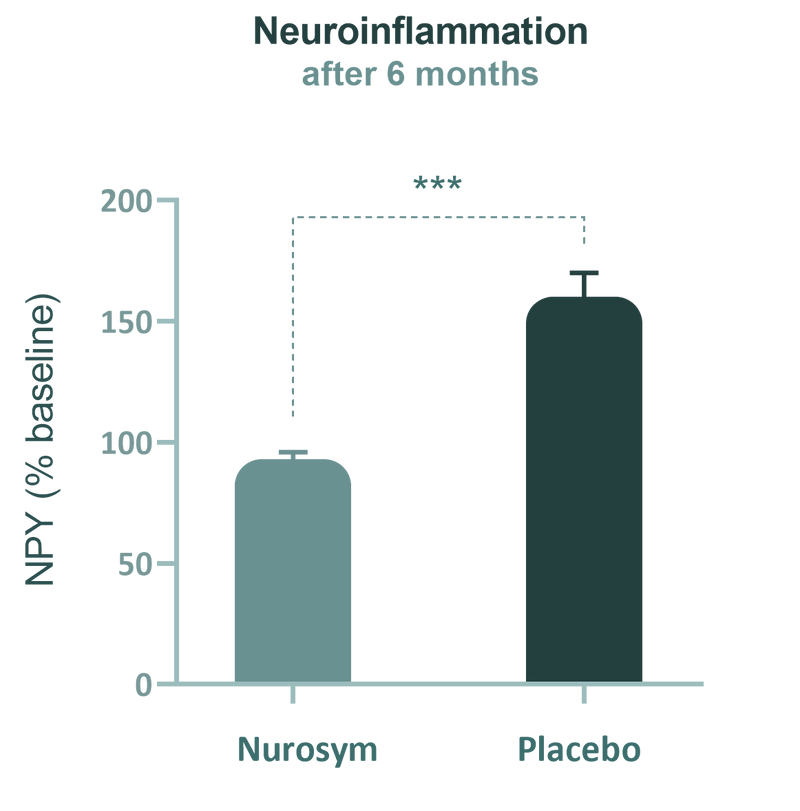
*Fig). A notable decrease in circulating neuropeptide Y (NPY) levels was observed after 6 months of Nurosym treatment. NPY is linked to the risk of multiple cognitive disorders (Parasym Clinical Trials, 2020).
Elevated reactive oxygen species (ROS) levels are linked to neurodegenerative disorders. Nurosym lowered ~24% ROS markers which may protect neurons and potentially slow the progression of conditions like Alzheimer's and Parkinson's disease.
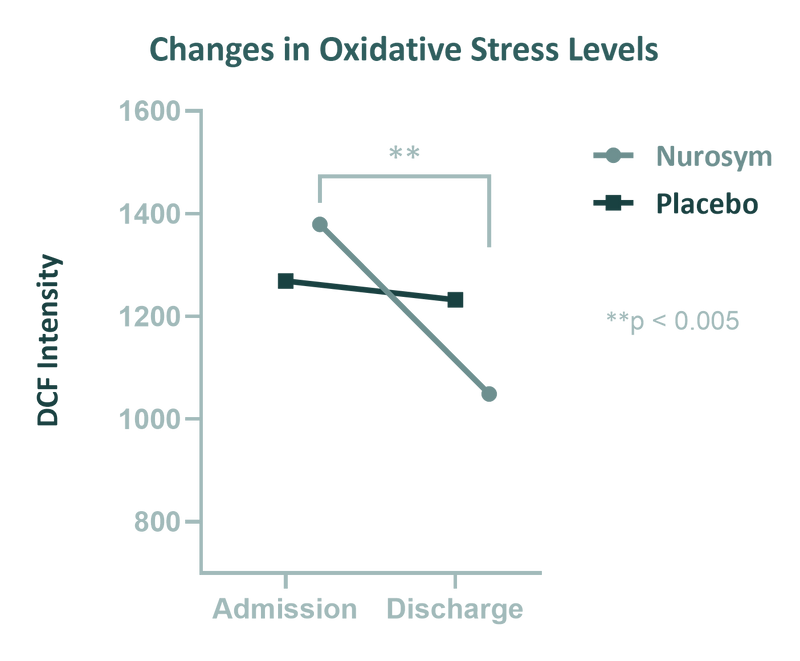
Fig. Effect of LLTS on oxidative stress. A Change in median values of DCF from admission to discharge in Nurosym group compared to control Placebo group (Parasym Clinical Trial, 2023)
Doctors about Nurosym
Patients about Nurosym
Yvonne
“I've been using the Nurosym device since January 2021. I use it every day for an hour and sometimes I achieve even more concentration. Sometimes I'll read a book while I've got it on. And I find that I'm able to concentrate sometimes on quite difficult pieces of writing”.
Who is for it?
Nurosym offers significant benefits for those seeking to prevent, slow down or even reverse cognitive decline and improve memory. In the realm of complex dementia-related conditions, where certain medications may have potential side effects, neuromodulation therapy like Nurosym emerges as a promising and non-invasive option.
Moreover, it proves valuable for patients recovering from brain injuries as Nurosym plays a crucial role in significantly improving blood supply to the brain.
Protocol - How to Use
Individuals with cognitive impairments can potentially benefit from the Nurosym device by using the device for two hours daily, divided into four 30-minute sessions. Begin each session 5 minutes before participating in cognitive activities like memory games, reading, or puzzles to optimise cognitive function.
For patients after brain injury, particularly those with motor impairments and vascular issues: incorporate the Nurosym device for up to four hours daily, divided into four 60-minute sessions to support brain health and underlying conditions. Start each session 5 minutes prior to engaging in physical therapy or exercises to potentially enhance motor learning and assist in the recovery process.
How often
Nurosym is recommended for use twice daily based on clinical research and patient feedback. This regimen ensures optimal energy balancing and nervous system calming.
How long
Users should allocate 30 minutes in the morning and 60 minutes before sleep for Nurosym therapy sessions. Consistency in application is key to achieving desired results.
Results
Positive outcomes from Nurosym therapy may become noticeable within a relatively short timeframe. Many individuals report improvements within days of starting treatment.

